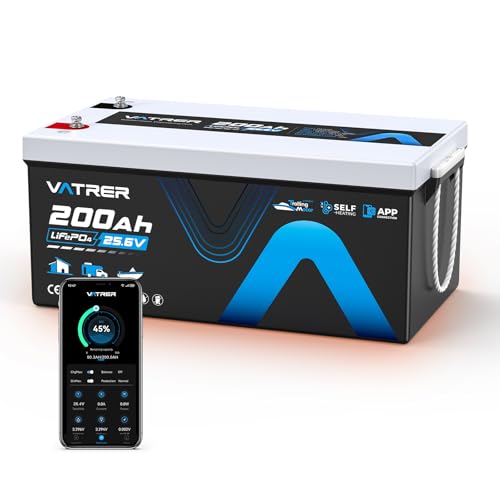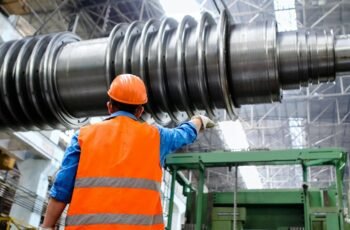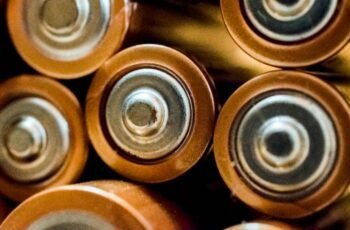Choosing a reliable 24V 200Ah LiFePO4 battery can make or break an off-grid or RV setup, so we’ve narrowed the options to three standouts for 2025. We’ll compare real-world capacity, BMS protection, expansion flexibility, cold-weather performance, and app monitoring. We’ll also note inverter compatibility and expected cycle life to help you match a battery to your system. If you want dependable power without guesswork, let’s start with the top pick…
Key Takeaways
- Redodo 24V 200Ah: 5,120Wh, 200A BMS, supports ~5,000W inverters, >4,000 cycles, 5-year warranty; ideal for RVs, cabins, and marine loads.
- LOSSIGY 24V 100Ah: lighter option with Bluetooth monitoring and included 15A charger; good for trolling motors and small off-grid setups.
- 24V 200Ah Self-Heating model: Bluetooth, 200A BMS, charges safely down to -4°F; best for cold climates and year-round off-grid use.
- All picks require 24V-compatible chargers/inverters and aren’t for engine starting; plan for weight (≈49–83 lb) and installation space.
- Expandability: most support up to 2 in series and 4 in parallel; verify BMS limits, cable sizing, and inverter power needs before stacking.
Redodo 24V 200Ah LiFePO4 Lithium Battery with 200A BMS (5120Wh)
November 19, 2025 5:53 pm
If you need a high-capacity pack that can handle serious loads without babysitting, the Redodo 24V 200Ah LiFePO4 with a 200A BMS stands out for off-grid cabins and RVs running inverters up to 5,000W. We get 25.6V nominal, 200Ah, and 5,120Wh of usable energy from EV-grade LiFePO4 cells. The 200A BMS safeguards against over-charge, over-discharge, over-current, short-circuit, and high temps. Expect over 4,000 cycles at 100% depth of discharge and up to a 10-year lifespan. At 82.67 lbs, it packs nearly 2.2x the energy density of two 12V 200Ah AGM. It’s expandable to 51.2V, 800Ah, backed by a 5-year warranty and 24/7 support.
Best For: Off-grid homeowners, RVers, and marine users needing a high-capacity 24V battery that can reliably power inverters up to 5,000W with minimal maintenance.
Pros:
- 5,120Wh usable energy with 200A BMS supports heavy loads (up to ~5,000W) and protects against over/under-voltage, over-current, short-circuit, and high temps.
- Long lifespan: >4,000 cycles at 100% DOD (up to 10 years) using EV-grade LiFePO4 cells; low 3%/month self-discharge.
- Scalable system: expand up to 51.2V, 800Ah; lighter and ~2.2x energy density versus two 12V 200Ah AGM batteries.
Cons:
- At 82.67 lbs, it’s still heavy for single-person installs or frequent relocations.
- Requires compatible 24V chargers/inverters; not a drop-in for 12V-only systems.
- Upfront cost likely higher than comparable-capacity lead-acid/AGM options (offset by cycle life).
LOSSIGY 24V 100Ah LiFePO4 Trolling Motor Battery with 15A Charger and Bluetooth BMS
November 19, 2025 5:53 pm
Need a lighter, smarter swap from lead-acid for a trolling motor or compact off-grid rig? We like LOSSIGY’s 24V 100Ah LiFePO4: 25.6V, 100A continuous (2560W), and a 100A Bluetooth BMS that surges to 400A for 3–5 seconds. It’s IP65 waterproof, about 48.7 lb, and rated for 4000+ cycles and up to 10 years.
The included 15A LiFePO4 charger makes setup easy. Use the app to track SOC, health, cycles, and temps. Run up to 4 in parallel or 2 in series. Expect snappier acceleration and major weight savings versus AGM. Operates -4°F–140°F discharge. Notes: charger can be noisy; secure wiring; check display weatherproofing.
Best For: Boaters and off-grid users who want a lightweight, high-output 24V LiFePO4 battery with Bluetooth monitoring to replace heavy lead-acid systems.
Pros:
- 100A continuous (2560W) with 400A peak for 3–5s, ideal for trolling motor bursts and acceleration
- Lightweight (~48.7 lb) and long life (4000+ cycles, up to 10 years) with IP65 waterproof rating
- Bluetooth BMS and app for real-time SOC, health, cycles, and temperature monitoring; 15A LiFePO4 charger included
Cons:
- Charger can be noisy and bulky during operation
- Charging limited to 32°F–113°F; cold-weather charging below freezing not supported
- Some external displays/accessories may not be weatherproof; reliance on Bluetooth app recommended
24V 200Ah LiFePO4 Battery with Bluetooth, Self-Heating, and 200A BMS
November 19, 2025 5:53 pm
For cold-climate RVers and off-grid cabins that charge year-round, this 24V 200Ah LiFePO4 stands out with a 200A BMS, Bluetooth monitoring, and automatic self-heating that safely enables charging from -4°F to 41°F. We get 5000+ cycles, UL-tested cells, and robust protections: overcharge, over-discharge, over-current, short circuit, and low-temp cutoff. It’s 30% lighter than lead-acid, offers fast charge/discharge, and delivers high output with low self-discharge.
We can expand up to 2S4P, mount in any position, and track health in the app—cell balance often within ~0.001V. Use for RV, marine, and solar storage; not for engine starting. Ensure a LiFePO4 charging profile.
Best For: Cold-climate RVers, boaters, and off-grid solar users who need a 24V, high-capacity LiFePO4 battery with Bluetooth monitoring, self-heating for safe low-temp charging, and robust 200A BMS protection.
Pros:
- Automatic self-heating enables safe charging from -4°F to 41°F; low-temp cutoff adds protection.
- Long lifespan (5000+ cycles), high output, fast charge/discharge, and ~30% lighter than comparable lead-acid.
- Bluetooth app for real-time status and tight cell balancing; supports up to 2 in series and 4 in parallel.
Cons:
- Not suitable for engine starting; designed for energy storage only.
- Requires a LiFePO4-specific charging profile and may need charger/DC-DC upgrades when replacing lead-acid.
- Heavier than smaller-capacity batteries (about 80.7 lb), which may impact installation in tight spaces.
Factors to Consider When Choosing 24V 200AH Lifepo4 Batteries
As we compare 24V 200Ah LiFePO4 options, we’ll weigh capacity and voltage against your load needs and check BMS specs for current limits, protections, and communications. We’ll assess cycle life, temperature tolerance for cold and heat, and how those affect real-world performance. We’ll also factor in weight and dimensions to ensure the battery fits your RV or off‑grid setup without compromising payload.
Capacity and Voltage
Let’s zero in on capacity and voltage because they dictate real-world runtime and system fit. A 24V 200Ah LiFePO4 pack delivers a nominal 24V with 200Ah capacity, translating to roughly 4.8kWh. Many labels list about 5.12kWh, reflecting precise cell voltages and usable range. What matters to us is usable energy: LiFePO4 often supports near 100% depth of discharge, so we can access most of that capacity without the penalty typical of lead-acid.
We should match capacity to daily loads and charging sources. Need more runtime? Parallel packs increase amp-hours; need higher inverter input? Series stacking can step to 51.2V. Remember, higher capacity at 24V usually means more mass and volume—around 80–83 pounds for 200Ah—so confirm space and mounting before committing.
BMS Specifications
Capacity sets how much energy we can store; the BMS determines how safely and effectively we can use it. For 24V 200Ah packs, we look for a robust 200A BMS that guards against over-charge, over-discharge, over-current, short-circuit, and high temperature. That protection keeps our system stable when loads spike and conditions shift.
A 200A rating also matters for performance. It supports high surge demands from inverters and motors without nuisance trips, giving us confident start-ups. We prefer Bluetooth or CAN-enabled BMSs for real-time cell data, state-of-charge, and health insights via an app, so we can spot imbalances early.
We also check expansion rules. Higher-rated BMS units typically allow safer series/parallel builds. Finally, low-temperature cutoffs, auto-balancing, and thoughtful thermal management improve cold-weather safety and reliability.
Cycle Life Longevity
While raw capacity tells us how long a pack runs today, cycle life tells us how many years it’ll keep doing it. For 24V 200Ah LiFePO4 batteries, we should expect 4,000+ cycles at 100% depth of discharge, with many premium packs reaching 5,000 or more under favorable conditions. That’s roughly 8–10x the durability of comparable lead-acid, meaning fewer replacements and lower lifetime cost.
We also look for high capacity retention across those cycles. Running a moderate depth of discharge and following sound charging practices preserves the cells’ chemistry, keeping usable capacity high over time. A robust BMS helps, too. Protections against over-charge, over-discharge, over-current, and short-circuit mitigate stress and extend longevity. When comparing models, verified cycle ratings and documented retention curves are key.
Temperature Tolerance
How hot or cold will your system run? Temperature tolerance matters for performance, safety, and longevity. Most 24V 200Ah LiFePO4 packs discharge reliably from about -4°F to 140°F (-20°C to 60°C). Charging is stricter: many BMS limits require 32°F to 113°F (0°C to 45°C). Below freezing, some models add low‑temperature protection or BMS‑driven self‑heating that enables safe charging down to roughly -4°F to 4°F (-20°C to -16°C) when a charger is connected.
We should plan installation with ambient swings in mind. High heat can trigger over‑temperature protection or thermal cutoffs, protecting cells and preserving cycle life. Cold reduces available capacity and charging efficiency. For storage, broader ranges (around 10°F to 122°F or -12°C to 50°C) help minimize degradation when the system sits idle.
Weight and Dimensions
Where will the battery sit, and can the space handle its mass? A 24V 200Ah LiFePO4 unit typically weighs 80–83 pounds (about 36–37 kg), so we need mounting points and cabinetry that safely support that load plus brackets, cabling, and any trays. Plan for safe lifting and clearances during installation and service.
Most packs measure roughly 10–11 inches deep, 20–21 inches wide, and 8–9 inches high. Let’s verify cutouts, door swings, ventilation gaps, and cable bend radius against those figures. Some models run bulkier or heavier if they integrate robust BMS hardware, cooling, or protective enclosures.
Compared with lead-acid, LiFePO4 gives similar capacity at roughly half the weight, freeing payload and space. Balance the battery’s position to keep RV or trailer weight distributed evenly.
Expansion Compatibility
Planning to grow the bank later? Let’s confirm expansion compatibility up front. Most 24V 200Ah LiFePO4 systems allow limited scaling—often up to 2S4P or similar—based on the BMS and pack design. We should read the BMS spec for maximum series and parallel counts so protection features (over-current, short-circuit) remain effective when we stack modules.
If we aim for higher voltage, we must keep system voltage within safe operating limits and ensure the charger, inverter, and any MOSFET/relay protections support the new configuration. Hardware matters too: verify terminal type, stud size, busbar spacing, and cable gauge to minimize resistance and heat.
Finally, check balancing, communication, and monitoring requirements so packs share current evenly, stay synchronized, and maintain cycle life across the expanded bank.
Conclusion
All three 24V LiFePO4 picks deliver dependable, long-lasting power for off-grid and RV setups. Redodo’s 24V 200Ah shines with its robust 200A BMS and expandability, while LOSSIGY’s 24V 100Ah wins on lightweight design and Bluetooth monitoring. The self-heating 24V 200Ah option stands out for cold-weather charging. As we choose, let’s match capacity, BMS ratings, cycle life, temperature needs, and expandability to our system. With the right fit, we’ll power adventures confidently and efficiently.





